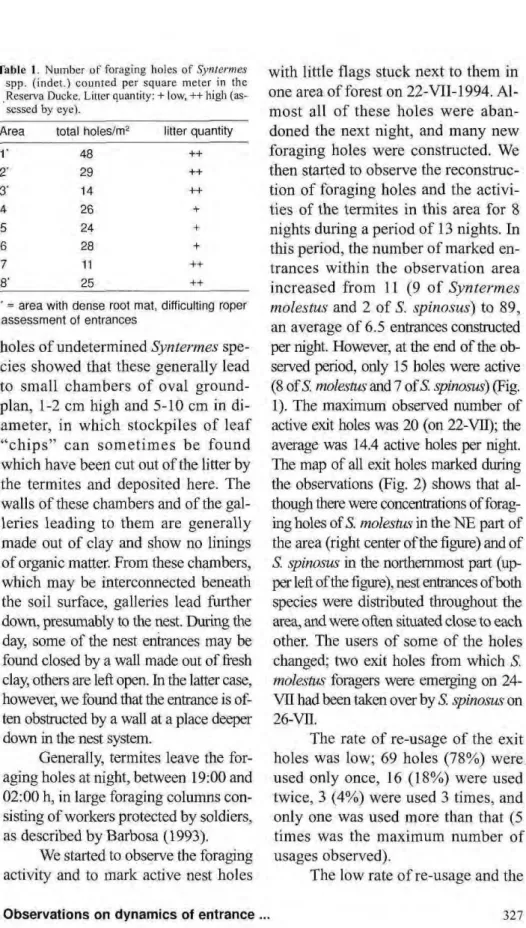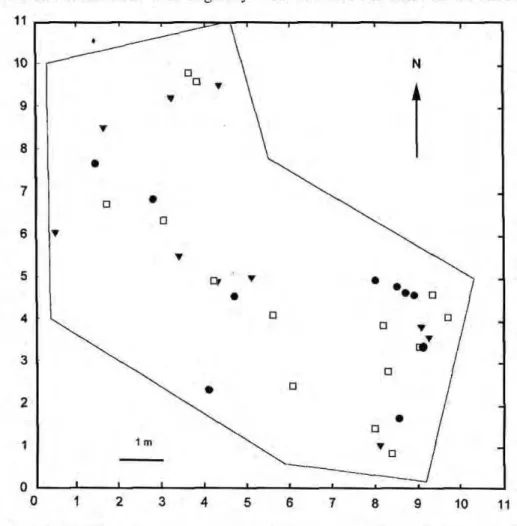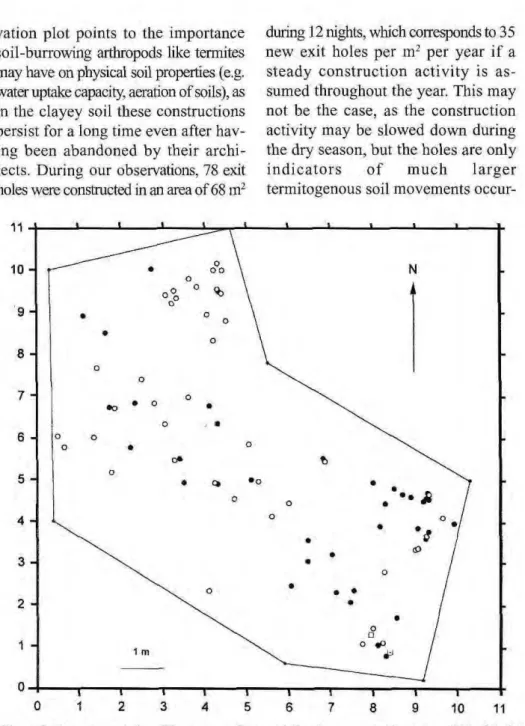OBSERVATIONS ON D Y N A M I C S OF F O R A G I N G H O L E CONSTRUCTION OF TWO LEAF-FEEDING, SOIL-INHABITINGzyxwvutsrqponmlkjihgfedcbaZYXWVUTSRQPONMLKJIHGFEDCBA Syntermes SPECIES (INSECTA: ISOPTERA) IN AN AMAZONIAN RAINFOREST, BRAZIL Christopher MARTIUS1
, Matthias WELLER2
ABSTRACT — The intensity of construction of foraging access holes by two leaf-litter feeding,
soil- inhabiting termite species, Syntermes molestus and Syntermes spinosus, in a Central Amazonian rain forest, was observed on consecutive nights for two weeks. Between 11 and 48 nest entrances per m2
were counted. Interaction between the two species was intense; some entrance holes were overtaken by the larger species during the observations; however, both species coexist in the
area. A calculated minimum of 35 entrances/m2
is built every year by both species, emphasizing the importance of soil-burrowing termites for soil structure, aeration and water regime.
Key Words: Leaf-litter feeding termites, soil-inhabiting termites, burrowing activity, soil density
Observações sobre a Dinâmica de Construção de "Olheiros" em Duas Espécies de Cupins Subterrâneos, Comedores de Folhas do Gênero Syntermes (Insecta: Isoptera) numa Floresta Amazônica, Brasil.
RESUMO — A intensidade de construções de saídas de forrageamento em duas espécies de cupins subterrâneos que se alimentam de serrapilheira, Syntermes molestus e S. spinosus, numa floresta tropical úmida da Amazônia Central, foi observada em noites consecutivas durante duas semanas. Foram contadas entre 11 e 48 entradas de ninho por m2
. A interação entre as duas espécies foi intensa; alguns dos olheiros foram conquistados pela espécie maior durante as observações; mesmo assim, ambas espécies coexistem na área. Um mínimo calculado de 35 entradas/m2 é construído cada ano por ambas as espécies, o que enfatiza a importância de cupins de solo para a estrutura, aeração e regime hídrico do solo.
Palavras-chave: Cupins comedores de serrapilheira, cupins de solo, atividade de escavação, densidade de solo.
1
II. Zoologisches Institut, Universität Göttingen, Berliner Str. 28, D-37073 Glöttingen, Germany [present address: ZEF, University of Bonn, Walter - Flex - Str. 3, D-53113 Bonn, Germany] 2
Tessinstr. 33, D-72072 Tubingen, Germany
INTRODUCTION zyxwvutsrqponmlkjihgfedcbaZYXWVUTSRQPONMLKJIHGFEDCBA
Leaf-litter feeding termites of the species Syntermes molestus and S.
spinosus are abundant in the primary
rain forest of the "Reserva Florestal Adolfo Dueke" in central Amazonia (Martius, 1998). These species forage at night on the forest floor where they cut pieces out of dead leaves which they carry to their nests (Bandeira, 1991). The density of foraging groups
subterra-nean nests are not discernible in the forest, we mapped the presence of nest entrances on a small plot and the ac-tivity of the termites at and around these entrances for 13 days. During these observations, we discovered an unexpectedly high activity of foraging
holes construction in both species. zyxwvutsrqponmlkjihgfedcbaZYXWVUTSRQPONMLKJIHGFEDCBA
MATERIAL AND METHODS
The study was carried out in the rain forest reserve "Reserva Florestal Adolfo Ducke", in Central Amazonia, near the city of Manaus. The reserve is covered by dense "terra firme" rain forest ( P r a n c e , 1990); the soil is mostly a nutrient-poor yellow clayey
latosol (oxisol) (ChauvelzyxwvutsrqponmlkjihgfedcbaZYXWVUTSRQPONMLKJIHGFEDCBA etal., 1987).
The climate is characterized by a short "dry" season (=monthly precipitation <100 mm) from July to September. The 1911-1990 average annual rainfall was 2 1 0 7 mm in t h e r e g i o n of Manaus, and average minimum and maximum air temperatures were 20 and 26°C, respectively ((Ribeiro, 1991). Information on leaf litter stocks is given in Hõfer et al. (1996).
The density of foraging holes of
Syntermes nests was determined on 8
plots of 1 m2
each, distributed at random throughout an area of 5 k m2
of the Reserva Ducke. The litter quantity at each plot was only visually estimated.
We made observations of the for-aging activity of two termite species,
Syntermes spinosus and Syntermes molestus in a separate area which
to-talled 68 m2
(Fig. 1). Specimens of both termites were collected for iden-tification in this area before the
obser-vation period. During a total period of 13 nights, we visited this area on 8 nights for observations and mapping of the active exit holes (entrances from which groups of foraging termites were seen emerging) of both species. During the observations, termites were left undisturbed as much as possible; they were identified by eye according to their size. The exit holes were mapped, numbered for re-identifica-tion and marked with little flags stuck into the soil near the entrances. Obser-vations were carried out for approxi-mately one hour each night.
RESULTS AND DISCUSSION
In areas where the two Syntermes species are active, we counted between
11 and 48 foraging holes per m2
(Tab. 1); but we could not determine which of the species had built them. Although some of the holes may have been produced by other soil-burrowing animals, most of them are of the typical size and shape of Syntermes nest entrances. We found no relationship between the number of holes and the amount of litter avail-able; however, a possible correlation may have been obscured by the fact that we could not distinguish between re-cent and old, active and abandoned en-trance holes. The density of active foraging holes, as determined in the area where the foraging dynamics were observed, was much lower; from about 0.15 holes/m2
at the beginning to 0.29 holes/m2
at the end of the obser-vation period of two weeks. Here, litter quantity was not assessed.
Table 1. Number of foraging holes ofzyxwvutsrqponmlkjihgfedcbaZYXWVUTSRQPONMLKJIHGFEDCBA Syntermes
spp. (indet.) counted per square meter in the Reserva Ducke. Litter quantity: + low, ++ high
(as-sessed by eye). zyxwvutsrqponmlkjihgfedcbaZYXWVUTSRQPONMLKJIHGFEDCBA
Area total holes/m* litter quantity zyxwvutsrqponmlkjihgfedcbaZYXWVUTSRQPONMLKJIHGFEDCBA
T 48 ++
2 ' 29 ++ 3' 14 + + 4 26 + 5 2 4 + 6 28 + 7 11 ++ 8' 25 ++ ' = area with dense root mat, difficulting roper assessment of entrances
holes of undetermined Syntermes spe-cies showed that these generally lead to small chambers of oval ground-plan, 1-2 cm high and 5-10 cm in di-ameter, in which stockpiles of leaf " c h i p s " can s o m e t i m e s be found which have been cut out of the litter by the termites and deposited here. The walls of these chambers and of the gal-leries leading to them are generally made out of clay and show no linings of organic matter. From these chambers, which may be interconnected beneath the soil surface, galleries lead further down, presumably to the nest. During the day, some of the nest entrances may be found closed by a wall made out of fresh clay, others are left open. In the latter case, however, we found that the entrance is of-ten obstructed by a wall at a place deeper down in the nest system.
Generally, termites leave the for-aging holes at night, between 19:00 and 02:00 h, in large foraging columns con-sisting of workers protected by soldiers, as described by Barbosa (1993).
We started to observe the foraging activity and to mark active nest holes
with little flags stuck next to them in one area of forest on 22-VII-1994. Al-most all of these holes were aban-doned the next night, and many new foraging holes were constructed. We then started to observe the reconstruc-tion of foraging holes and the activi-ties of the termites in this area for 8 nights during a period of 13 nights. In this period, the number of marked en-trances within the observation area increased from 11 (9 of Syntermes
molestus and 2 of S. spinosus) to 89,
an average of 6.5 entrances constructed per night. However, at the end of the ob-served period, only 15 holes were active (8 of S. molestus and 7 of S. spinosus) (Fig. 1). The maximum observed number of active exit holes was 20 (on 22-VH); the average was 14.4 active holes per night. The map of all exit holes marked during the observations (Fig. 2) shows that al-though there were concentrations of forag-ing holes of S. molestus in the NE part of the area (right center of the figure) and of
S. spinosus- in the northernmost part
(up-per left of the figure), nest entrances of both species were distributed throughout the area, and were often situated close to each other. The users of some of the holes changed; two exit holes from which S.
molestus foragers were emerging on
24-VII had been taken over by S. spinosus on 26-Vn.
The rate of re-usage of the exit holes was low; 69 holes (78%) were, used only once, 16 (18%) were used twice, 3 (4%) were used 3 times, and only one was used more than that (5 times was the maximum number of usages observed).
large rate of rebuilding of exit holes is interestihg and may be a result of aggressive interactions between both species. In the laboratory, they fight fiercely when they meet, but this may be due to the confinement, and mutual avoidance upon encounters may be a more natural behaviour. The vicinity of exit holes and foraging areas of the two species leads to frequent encounters.
Two exit holes which were originally zyxwvutsrqponmlkjihgfedcbaZYXWVUTSRQPONMLKJIHGFEDCBA
11
used byzyxwvutsrqponmlkjihgfedcbaZYXWVUTSRQPONMLKJIHGFEDCBA S. molestus were taken over by
the larger species, S. spinosus; however, both species coexist apparently in stable assemblages. However, we can not rule out the possibility that the disturbance by our frequent observations with head lanterns induced a stronger building behaviour in the termites.
The difference between the ber of entrances (Tab. 1) and the num-ber of active exit holes on the
obser-10
9
8
7
6
» zyxwvutsrqponmlkjihgfedcbaZYXWVUTSRQPONMLKJIHGFEDCBA
1
- N J
• \
• T \
- v \
1
T zyxwvutsrqponmlkjihgfedcbaZYXWVUTSRQPONMLKJIHGFEDCBA
•
•
•
zyxwvutsrqponmlkjihgfedcbaZYXWVUTSRQPONMLKJIHGFEDCBA-•
-T
Or 1
*
•
#•
• •
•
• /• • /
• • /
T /
* /
• zyxwvutsrqponmlkjihgfedcbaZYXWVUTSRQPONMLKJIHGFEDCBA/
• •
•1 m •
• zyxwvutsrqponmlkjihgfedcbaZYXWVUTSRQPONMLKJIHGFEDCBA
^——
1 11 8 10 11
Figure 1. Nest entrance holes of Syntermes molestus and S. spinosus mapped in an area of 68 m2 in - the Reserva Florestal Adolfo Ducke, Central Amazonia, during 13 nights. In this map, no
vation plot points to the importance soil-burrowing arthropods like termites may have on physical soil properties (e.g. water uptake capacity, aeration of soils), as in the clayey soil these constructions persist for a long time even after hav-ing been abandoned by their archi-tects. During our observations, 78 exit holes were constructed in an area of 68 m2
during 12 nights, which corresponds to 35 new exit holes per m2
per year if a steady construction activity is as-sumed throughout the year. This may not be the case, as the construction activity may be slowed down during the dry season, but the holes are only i n d i c a t o r s of m u c h l a r g e r
termitogenous soil movements occur-zyxwvutsrqponmlkjihgfedcbaZYXWVUTSRQPONMLKJIHGFEDCBA
11
10 -zyxwvutsrqponmlkjihgfedcbaZYXWVUTSRQPONMLKJIHGFEDCBA
9
8
5
4
3
2
1
-_—— """*""""*"" """"" "*& \
•— • o o N
o zyxwvutsrqponmlkjihgfedcbaZYXWVUTSRQPONMLKJIHGFEDCBA
0% ° *>
o
o
• o
o o
o •o • °
o , •
o O
o • o
o» o
• d • o • ^ 7
o o
* /
o
• •
v 7
•• / o /
/
• / • /
o / . o /
1 m
1 m \ ^ è> /
o 1 4 8 10 11
Figure 2. Nest entrance holes ofzyxwvutsrqponmlkjihgfedcbaZYXWVUTSRQPONMLKJIHGFEDCBA Syntermes molestus and S. spinosus mapped in an area of 68 m2
ring beneath the surface. zyxwvutsrqponmlkjihgfedcbaZYXWVUTSRQPONMLKJIHGFEDCBA
ACKNOWLEDGEMENTS
T h i s study w a s financed by Deutsche Forschungsgemeinschaft and logistically supported by INPA. Thanks are due to Joachim Adis, Max-Planck-Institut Plõn, Hubert Holer, Staatliches Museum für Naturkunde, Karlsruhe, and Jo Darlington, Univer-sity of Cambridge, who all gave valu-able comments on a previous draft of this paper.
Literature cited
Bandeira, A. G. 1991. Termites (Insecta: Isoptera) consumidores de liteira na Ilha
de Maracá, Roraima.zyxwvutsrqponmlkjihgfedcbaZYXWVUTSRQPONMLKJIHGFEDCBA Acta Amazônica,
21: 15-23.
Barbosa, R. I. 1993. Período de forrageamento de duas espécies dc Syntermes (Isoptera, Termitidae) em uma floresta tropical amazônica e a relação com temperatura e umidade do ar. Revta. bras. Ent.,
37(4): 763-767.
Chauvel, A.; Lucas, Y.; Boulet, R. 1987. On the genesis of the soil mantle of the region of Manaus, Central Amazonia, Brazil.
Experientia, 43: 234-241.
Constantino, R. 1 9 9 5 . R e v i s i o n o f the neotropical genus Syntermes Holmgren (Isoptera: Termitidae). The University of Kansas Science Bulletin^ 55(13): 455-518.
Darlington, J.RE.C. 1995. Underground forag-ing passages and storage pits built by the termite Syntermes molestus in Goiânia, Brazil (Isoptera: Termitidae). Sociobiol-ogy 23(2): 211-212
Hõfer, H.; Martius, C ; Beck, L. (1996). Decom-position in an Amazonian rain forest af-ter experimental litaf-ter addition in small plots. Pedobiologia, 40(6): 570-576.
Martius, C. (1998). Occurrence, body mass and b i o m a s s o f Syntermes s p p . (Isoptera: Termitidae) in Reserva Ducke, Central A m a z o n i a . Acta Amazônica 28(3): 319-324.
Prance, G.T. 1990. The floristic composition of the forests of central Amazonian Brazil.
In: Gentry, A.H. (ed.) Four Neotropical Rainforests. New Haven, Yale University Press. 112-140.
Ribeiro, A. 1991. Análise das variações climáticas observadas na região de Manaus (AM). M.Sc. thesis. University of São Paulo, São Paulo.


